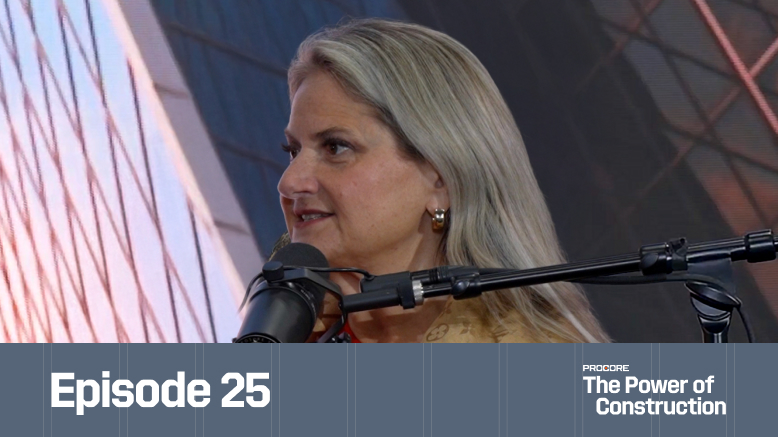— 7 min read
Architecture Competitions: Balancing Innovation with Professional Value


Last Updated Oct 3, 2025

Mary Carroll-Coelho
Product Operations
12 articles
Mary Carroll-Coelho is a Product Operations Manager at Procore. A licensed Architect, Mary previously worked for KieranTimberlake, an architecture firm in Philadelphia, in construction and product operations at WeWork, and Director of Customer Success at Willow. She holds a Master of Architecture from the University of Pennsylvania. Outside of work, she volunteers as a mentor in the Spark program.

Kacie Goff
Contributing Writer
90 articles
Kacie Goff is a construction writer who grew up in a construction family — her dad owned a concrete company. Over the last decade, she’s blended that experience with her writing expertise to create content for the Construction Progress Coalition, Newsweek, CNET, and others. She founded and runs her own agency, Jot Content, from her home in Ventura, California.
Last Updated Oct 3, 2025

Architecture competitions are precisely what they sound like: competitions during which architects submit designs in the pursuit of an award. Sometimes, that award is the contract for the building. Other times, the architect simply wins bragging rights and a strong pillar in their portfolio.
Many argue that architecture competition design submissions push the boundaries. Because a competition might encourage innovation and creativity, it allows architects to break free from the norm. However, others counter that architecture competitions can take advantage of the architects, getting them to submit designs for little to no money.
The reality lies somewhere in the middle. These competitions can be useful to both owners and architects, provided all parties understand what they’re getting themselves into.
Table of contents
The History and Current State of Architecture Competitions
Architecture competitions aren’t anything new. Per the Smithsonian, these contests date back to 448 BCE, when city officials in Athens invited designs for a memorial commemorating the Greco-Persian war. Fast forward thousands of years and these competitions thrive around the globe.
ArchDaily, the architecture-focused publication, maintains a database of many of the current competitions. There are currently more than 3,000 open and featured on that site alone, including more than 80 just for hotels.
Some competitions today focus on driving design forward in specific areas. The competition might call for a higher level of technological integration or more stringent sustainability standards than are common on most projects, for example.
Some of these contests happen on a regular basis — like the Young Architects Program run by the Museum of Modern Art (MoMA) and MoMA PS1 — while others are conducted ad hoc when an entity needs a design for a specific structure, like the Guggenheim Helsinki Design Competition (although the Helsinki City Council eventually voted against building a Guggenheim in Helsinki, the contest drew international attention).
As issues like affordable housing and sustainability become increasingly pressing, some organizations have launched architecture competitions in an attempt to find solutions. The Seoul Metropolitan Government in South Korea, for example, has held international design competitions over the last three years to drive its Seoul Compact City plan forward. The United Nations Economic Commission for Europe (UNECE) is currently spearheading a project to revitalize neighborhoods in Kharkiv, Ukraine.
While these competitions vary in their scale and scope, they have one thing in common: They’re contests in which architects submit their architecture competition design based on the contest’s brief. This differentiates them from architecture prizes, like the Pritzker Architecture Prize. That designation — and other awards like it — recognizes architects for their overall contribution to the field, rather than a specific design.
The Varying Scale of Architecture Competitions
Not all architecture competitions are created equal. Any organization can host this type of contest, so they range widely. Some contests are open, meaning they allow architecture competition design submissions from anyone who meets the contest criteria. Others are only open to architects and firms who receive an invitation.
Some are single-stage, while others invite a wide pool for the first stage, then narrow down participants, usually by having a group review the initial batch of architecture competition design entrants.
The way a winner is determined also varies. Some architecture competitions are open for public review, and the public may even vote on the winner. Others leverage a jury. Some contests leave the winner at the sole discretion of the project owner or their project management team.
In other words, architecture competitions span a wide range. They can be as simple as a local event to which anyone can submit a design or as complex as an international invite-only contest with a jury.
Why, though, are organizations running these contests, and why are architects giving up their time to compete in them? That depends. In some instances, the competition is part of the predevelopment phase of a planned project. In others, the primary goal is community engagement. Each architecture competition host organization has its own goals, and participants have their own reasons for getting involved.
Stay updated on what’s happening in construction.
Subscribe to Blueprint, Procore’s free construction newsletter, to get content from industry experts delivered straight to your inbox.

The Benefits of Architecture Contests
Both the host organization and any participants who submit an architecture competition design can see an upside.
Benefits to the Host Organization
While organizing architecture competitions takes some work, the hosts stand to gain a lot. They often get a wide variety of design options, often featuring innovative touches. And since most contests don’t pay participants (save for prize money — and some contests skip even that), they provide the opportunity to widen the host’s option pool without expanding their costs.
Beyond that, architecture competitions can help the host organization foster community engagement and goodwill. Publishing entries can help to generate excitement for the planned structure — and provide a low-risk way to test the public’s approval of potential options.
Career Advantages for Participants
Many people and firms who submit designs expect to generate some clout in doing so. That makes architecture competitions particularly advantageous for architects early in their careers who want to build their portfolios, and more established architects hoping to build a sufficient reputation to start their own firm.
Because many architecture competitions publish the submitted designs online or at another public forum, the contest gives participants a way to expose their work to a wider audience.
Plus, if the architect or firm wins, they may see more than a reputation boost. Some architecture competitions offer prize money, while others award the winner the contract for the project in question. This saves the architect from having to go through the traditional bidding process, moving them straight to negotiated tendering.
Potential Drawbacks to Architectural Competitions
Hosting and competing in an architecture contest isn’t without its potential problems.
Considerations for Host Organizations
By opening up an architecture competition, the host organization makes the requirements for their structure public. This can expose them to some risk, particularly from competitors.
Beyond that, if host organizations aren’t careful about the wording of the language with which they legally bind the contest, they can run into intellectual property (IP) issues. Architects can argue that the submitted architecture competition design is their IP, making it challenging for the host organization to use that design if they can’t get the architect under contract.
Plus, the contest could generate public excitement without the proper planning in place, as was the case with the Guggenheim project in Helsinki. The Solomon R. Guggenheim Foundation invested time, energy, and resources into running the international contest. But because the proper authorities (namely, Helsinki city officials) weren’t involved — and ultimately voted against putting a Guggenheim in the city — it was all for naught, at least as far as a tangible structure was concerned.
The Drain on Architects
Similarly, architecture competitions present IP issues for the architect. They could be giving away their architectural property for free.
Additionally, because most contests don’t pay participants in any way beyond prize money (if that), there’s the time and resource allocation to consider. If the architect takes on the project on their own, they are essentially volunteering their time and expertise. And if a firm decides to participate, it needs to consider the overhead required to pay its team as they engage with the competition.
In fact, the competition could become such a strain that the architect or firm submits subpar work just to get it off their desk. But because submissions are often published publicly, this could damage their reputation.
Ultimately, participating in architecture competitions often requires the same level of effort as creating a design for a paying client. Potential participants should evaluate the upside and determine if that investment of time and resources is worth it.
Deciding When To Host or Compete in an Architecture Competition
Anyone interested in hosting an architecture competition should carefully consider what their group stands to gain from the contest. It can generate innovative ideas and engage a wider audience. But because it steps outside the traditional architectural concept development process, it could introduce hurdles like pushback from the applicable Authorities Having Jurisdiction (AHJs).
When the host does decide to move forward, creating a thorough brief for the contest that outlines how intellectual property gets handled and what, if anything, the host promises to the winner helps to avoid issues.
For architects and firms, the decision to participate in architecture competitions should be handled as carefully as the decision to accept a paying project. Will the yield be worth the time, money, and effort from personnel required? For architects early in their careers or firms trying to establish their reputation, the notoriety may indeed be payment enough for submitting their own architecture competition design.
NOV 6, 2025 at 11:00 AM PST / 2:00 PM EST
Free Webinar: Prove your project management software is profitable
Join Procore and Dodge Data & Analytics for a 2025 Dodge ROI Report deep dive.

Was this article helpful?
Thank you for your submission.
0%
0%
You voted that this article was . Was this a mistake? If so, change your vote
Scroll less, learn more about construction.
Subscribe to The Blueprint, Procore’s construction newsletter, to get content from industry experts delivered straight to your inbox.
By clicking this button, you agree to our Privacy Notice and Terms of Service.
Thank you!
You’re signed up to receive The Blueprint newsletter from Procore. You can unsubscribe at any time.
Categories:
Written by

Mary Carroll-Coelho
Product Operations
12 articles
Mary Carroll-Coelho is a Product Operations Manager at Procore. A licensed Architect, Mary previously worked for KieranTimberlake, an architecture firm in Philadelphia, in construction and product operations at WeWork, and Director of Customer Success at Willow. She holds a Master of Architecture from the University of Pennsylvania. Outside of work, she volunteers as a mentor in the Spark program.
View profile
Kacie Goff
Contributing Writer | Procore Technologies
90 articles
Kacie Goff is a construction writer who grew up in a construction family — her dad owned a concrete company. Over the last decade, she’s blended that experience with her writing expertise to create content for the Construction Progress Coalition, Newsweek, CNET, and others. She founded and runs her own agency, Jot Content, from her home in Ventura, California.
View profileExplore more helpful resources

Defending Against Financial & Legal Risks on Megaprojects
The construction industry has seen marked growth in megaprojects. Some experts classify any project over $500 million as a megaproject, while others argue that the build needs to be $1...

Unlocking Project Intelligence: Moving from Raw Data to Actionable Insights
The construction industry faces a wide range of challenges, from ongoing labor shortages to frequent cost overruns. But some the biggest hurdles all stem from unpredictability. The general contractors (GCs)...

Who is accountable for innovation in construction?
Everyone says construction needs to innovate—but no one agrees on who’s actually responsible for making it happen. Is it the owner? The builders? The tech vendor? Or is innovation everyone’s...

Integrated Project Delivery in Practice: A Framework for Collaboration
On construction projects, traditional delivery methods put different stakeholders in their own silos. While the design team feeds drawings and specifications to the general contractor (GC), the GC’s expertise in...
Free Tools
Calculators
Use our calculators to estimate the cost of construction materials for your next project.
Templates
Find a template to help you with your construction project tasks.
Material Price Tracker
Get the latest U.S. retail prices and view historical trends for common building materials.
Glossary
Explore key terms and phrases used in the industry.
